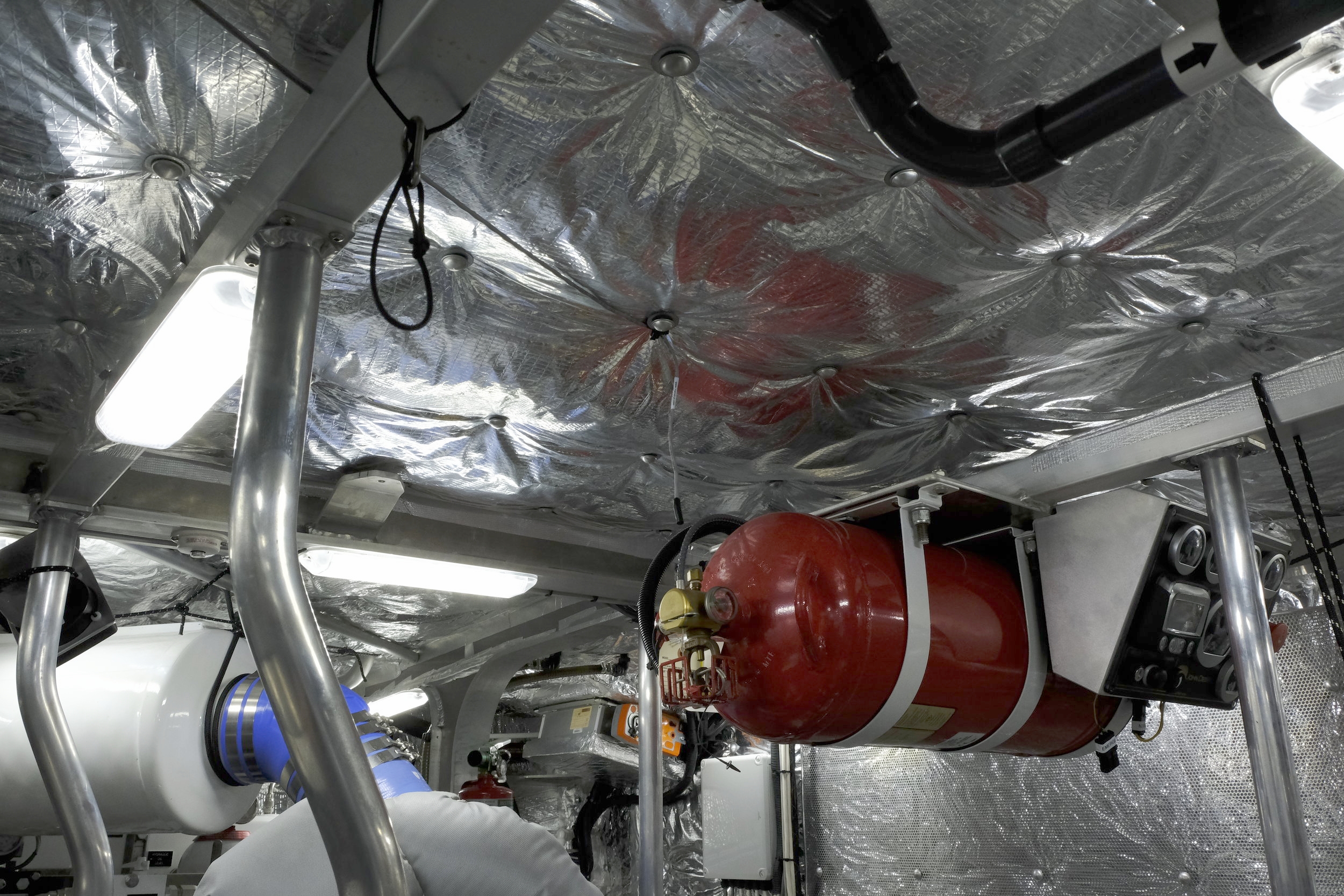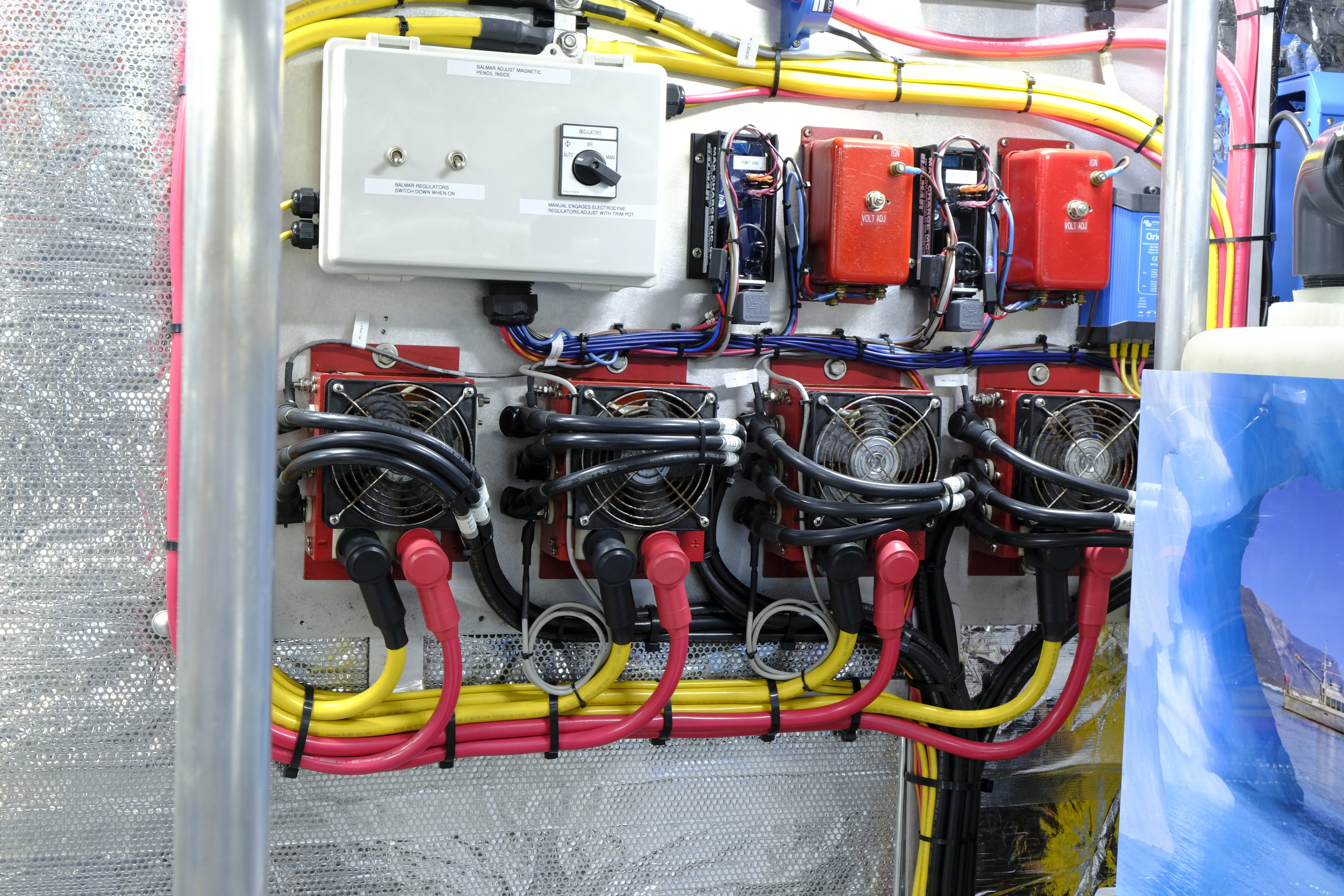As we discussed a couple of weeks ago, Cochise is quite a vessel. I took lots of pictures and Steve Dashew walked me through the boat and pointed out many interesting details that he iincorporated into this 78-foot FPB. To review the previous posts, take a look at:
Part 1 http://bit.ly/Ultimate_FPB_1
Part 2 http://bit.ly/FPB_Part2
Now, for the final part of this review, here are some engine room details.
The aluminum structure on the aft cockpit forms the grilling and cooking area, as well as storage for pots and pans to complement the ship's galley. It is a versatile work surface that does duty under way and at anchor. On the backside of this island are large grates that are part of the engine room ventilation. The staples stored here can be installed in the saloon by uncovering plugs in the saloon sole and fitting these hand rails for security at sea if heavy weather is anticipated. The dogged hatch provides access to the aft end of the engine room where the steering and workshop are located.
The bottom end of the ventilation structure from the cockpit island enters the aft end of the engine room. Three Delta-T fans pressurize the engine room under way, giving the two Deere diesels plenty of fresh air for maximum performance. In case of electrical or other failure of these high-volume fans, the entire bottom of this ventilation unit swings open (see the three massive hinges on the bottom plate holding the fans), allowing unpressurized air to continue feeding lots of air into the engine room. This is a really well thought out detail and an ideal setup for long distance voyaging.
Two full-size Halon bottles mounted in the engine room ensure swift response to any fire threat. Steve says each is fully sized for the entire engine space, but he would never rely on just one system to do the job, in case someone opens a hatch or otherwise compromises the ability of the single bottle to handle a fire. The second is a critical backup...just in case.
Note the electrical connectors hanging down from one of the engine control panels. In case of electronic engine control failure, manual controls can be plugged into these connectors, bypassing the normal electronic controls for throttle and other functions.
One of the engine's raw water strainers, a brilliant feature worthy of every passagemaker. The strainer is above the waterline.
The top of the strainer is super easy to access and unscrew, and the strainer is always full of water. This feature provides three important functions. First because it is full of water, there will never be a dry start of the engine, as there will always be water in the hoses on the engine side of the strainer.
Second, it is easy to flush the engine with fresh water when stopping for more than a day or two, eliminating raw salt water sitting in the cooling circuits, eating away at the zincs.
And third, it is really easy to clean the strainer. This is the best of all strainer installations in my opinion. Super well done.
With the grate flooring removed, you can better see large pipe that comes up to the raw water strainer just above the waterline. You also can see the bottom of the boat and that all fixtures are accessible. Notice how clean this space is, giving the boat launches a year ago and has traveled from New Zealand to Annapolis, via Fiji, Panama, and Nova Scotia...and dozens of other cruising destinations. It is easy to fall in love with such attention to detail. Nothing is inaccessible, buried out of sight.
These four, remotely mounted bridge rectifiers (diode bridges) take the conversion from AC to DC out of the four engine-mounted alternators (two per engine), which removes heat from the alternators and reduces the single biggest point of failure of an alternator. This makes so much sense, and you might consider doing the same on your boat if your aim is to minimize points of failure.
Cochise doesn't not currently have any engine room cameras, but Steve is planning to install them. He normally does not use them because he is of the school who insist on hourly engine room checks to physically inspect, smell, and touch what is going on in the engine room. Unfortunately, given the size and relative complexity of this boat, he feels it takes way too long to get here from the helm and do a thorough engine room check, and then return to the helm. He is simply away from the helm far too long, even assuming there is nothing to attend to in the engine space. So mounting engine room camera is on the list of winter projects.
Note the massive steering gear, with my iPhone for comparison. There are two completely isolated steering systems, each with its own hydraulic cylinder. Only one system is used at a time. The Accu-Steer units are from Washington State. The forward-facing pin on the steering is for fitting emergency manual steering, a system that can be rigged up for manual operation, although practically it will basically just lock the steering on center in the event of failure.
Now here is some cool stuff you don't see everyday. This is the second separate steering system on the port side of the boat. It consists of two identical Accu-Steer units, of which only one is normally online when he uses this redundant system.
The steering system on Cochise allows the rudders to turn through 45 degrees, which takes about 13 seconds from lock to lock. If Steve elects to bring the second pump online, in parallel to the first pump of this system, he can turn the rudders from lock to lock in about 7 seconds. This allows incredible maneuverability, as witnessed in Ft Lauderdale where he spun the big FPB in a narrow fairway, with only a few meters on either side of the boat as it turned around with mega yachts lining both sides. Given he does not use a bow thruster, this system gives him amazing turning ability, especially with two, enormous 32-inch props that take advantage of the torque from the John Deere engines.
Steve has a jog stick at both helms, and he can bypass the autopilots (which is his normal method of steering) and control the pumps directly if there is a lightning strike that takes out any of his electronic controls.
All in all, Cochise in a very unusual passagemaker, with so much innovation and creative thinking that is all over this boat. My neighbors still grill me about her, and it was a thrill to spend time on such a marvelous vessel.
Steve and Linda decided to stop producing any more boats in the FPB program, and for good reason. They put a great amount of personal time into each boat, and this hands-on attitude is how they built all of their previous sailboats and FPBs. This personal connection is the only way to make sure it is done right, to their precise standards, and that is not something lightly handed off to someone else.
So they decided they want to spend more time on the water, and with family, instead of continuing to fly across the world supervising and managing additional construction projects. It sadly makes sense, even if we will miss the fruits of their genius and labors. This remarkable couple proved that there are many new ideas out there waiting to be uncovered by fresh thinking. This stands in marked contrast to mainstream boat builders who rely on tradition.
I personally wish this lovely couple Fair Winds and Following Seas. Until we meet again, Steve and Linda. You are an inspiration to us all.

















